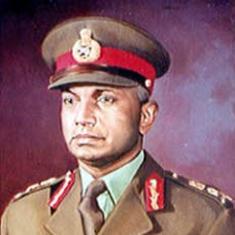Ravi Shankar
Raga Parameshwari
Raag Parmeshwari bears close resemblance to raag Ahiri Todi, and yet, it has a life of its own. In this track, Ravi Shankar begins with a detailed aalaap or introductory section. He explores the melody in the mandra (an octave below the middle) and anumandra (two octaves below the middle) region, before moving higher into the middle and upper octaves. He uses ornamentations like meends or gradual slides between notes, gamaks or rapid oscillations on each note, and krintan that involves the sound production of a note by plucking with a finger of the left hand rather than the normal plucking with the mizrab or plectrum. The free-flowing melody in the aalaap also contains a jod that introduces a pulse and later moves to the jhala played at great speed with repetitive strokes of the right hand.
Tabla wizard Alla Rakha establishes the grand canvas of the Dhamaar taal, a cycle of 14 matras or time units, for the melodic composition. Originally, a taal meant for the pakhawaj, Dhamaar has been incorporated into the tabla repertoire for accompaniment to certain forms and compositions as also for tabla solo recitals. Ravi Shankar breaks away from the reposeful aalaap, to a busy exploration of the composition in Dhamaar, with extensive layakari or cross-rhythmic variations and tihais or rhythmic patterns that are played thrice and are mathematically calculated for the last syllable of the third round to coincide with the sam/sum or the first matra of the cycle. Alla Rakha responds similarly to heighten the excitement. Clearly, the composition in Dhamaar is treated in a manner, which would evoke stylistic features of the dhamaar form in vocal music. The use of a tabla tuned to the lower fourth also evokes the tonal range of the pakhawaj.
Ravi Shankar
Raga Jogeshwari
Jogeshwari is yet another raag composed by Ravi Shankar. A marvellous combination of the raags Jog and Rageshree, this raag has also been presented primarily by Ravi Shankar and his disciples. On this track, Ravi Shankar is once again accompanied by the revered tabla player Alla Rakha. After an aalaap, Ravi Shankar plays a gat or instrumental composition in the ten matra Jhaptaal employing a great deal of layakari and tihais, at times with gamaks or with just plain, staccato notes. This composition is followed by a drut gat or fast instrumental composition in the 12 matra Ektaal. The taans or quick melodic passages are punctuated with a sense of urgency marked by the chikaari or the last strings tuned to the upper tonic. The recital ends in a jhala.










